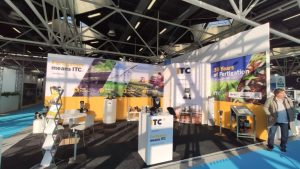Given the characteristics of the most common filtration and pump headers in irrigation communities, and their possible operation at very different flow ranges, it is necessary to have equipment that can adapt the injection to them.
Discouraged Systems
Since these headers usually operate at pressures above 5 bars and flow rates in the maximum range of 200 to 600 m3/h, the use of Venturi-based systems is inadvisable, as this will result in a loss of at least 30% of the pressure or the oversizing of an already high-cost system, which would require additional control of the injected volume of each product.
The use of non-proportional hydraulic injector pumps is also discouraged, as this type of dosing pump extracts part of the flow from the system, which is not always acceptable. They are not easily controllable under different or variable flow conditions. Proportional hydraulic dosers create a reduced pressure loss; however, they are not suitable as the sizing is insufficient for the usual flow rates in these types of installations.
Recommendations
Dosers in a fertigation system in an irrigation community must meet a series of requirements to ensure a proper choice:
- Safety: Resistance to the dosed chemicals and working pressures, protection of access to moving parts (especially the back chamber of the piston and ventilation).
- Precision
- Mechanical reliability
- Correct sizing
- Control possibilities
- Ease of use for the irrigator and technician
All these characteristics can be achieved through the use of piston electric dosers prepared for the dosing of fertilizers and acids, properly regulated by suitable controllers.
It is evident the importance that the installation itself and the other concurrent elements (pipes, wiring, valves, etc.) have in maintaining these characteristics, as well as observing an appropriate maintenance program and using quality fertilizers.
Typical Fertigation Installation for Irrigation Communities
The equipment for practicing fertigation essentially consists of:
Fertilizer Tanks
For the storage of the product to be dosed (fertilizer, acid, or other complementary products), which must be resistant and sized according to the purchase and replenishment strategy or product preparation, ensuring sufficient autonomy of the same. In case of preparing the product “in situ” from the dissolution of soluble products, an agitation system should be provided to facilitate the rapid preparation of the liquid to be injected.
It may also be necessary to provide systems for transferring chemicals between different tanks, usually centrifugal pumps resistant to fertilizers.
It is useful to have visualization and level detection systems in the tank to avoid the unforeseen depletion of them and the “dry running” of the dosers, which can damage collars, pistons, and valves.
Fertilizer Injector Pumps
This is the device that pumps the products, an electric three-phase dosing pump powered through a frequency converter, usually a piston, less commonly a diaphragm. There should be as many pumps as products to be dosed simultaneously.
They must be sized according to the water and nutritional needs of the crops to be irrigated and the climate of the region. This sizing cannot be done simply based on the average rainfall but must consider the incidence of infrequent periods of higher rainfall or lower ETP than usual. In these periods, the irrigation allocation decreases, but not the nutrient need (which can even be higher if deficit irrigation techniques are usually applied), so we should supply the same amount of nutrient during fewer cycles or irrigation time.
Electric Conduits
We basically find two conduits: suction (from the tank to the suction valve of the doser) and injection (from the doser to the injection valve in the main irrigation pipe). A third conduit is the return to the tank or purge if there are relief valves or purge valves. Proper sizing of the pipes is crucial, especially the suction pipe, considering the length and height differences between the various devices and accessories.
Common errors in suction conduits include undersizing, excessive height difference, and the presence of siphons (a high point where the air or gases eventually accumulated cause a bottleneck in the product flow).
Common errors in injection conduits include undersizing and the presence of manually operated valves (especially dangerous if there are no relief valves). It is also advisable to have a system to prevent accidental discharge of the product from the tanks to the irrigation pipe if it becomes empty, depressurized, or under vacuum (“siphoning“), whether it be a spring-loaded non-return valve or an anti-siphon valve.




